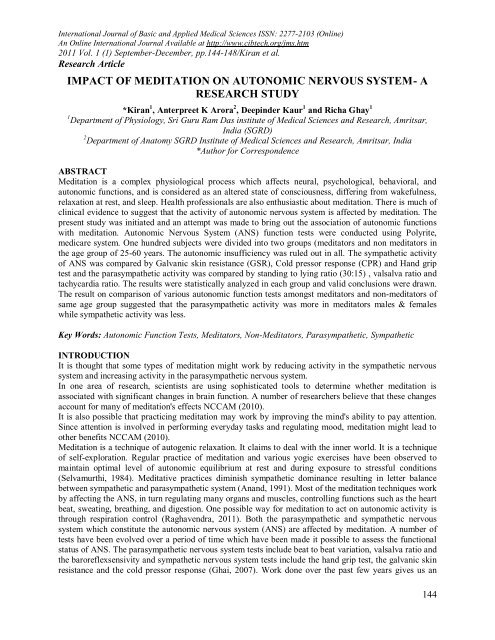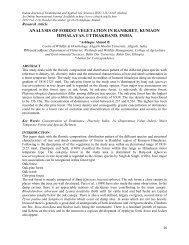impact of meditation on autonomic nervous system - CIBTech
impact of meditation on autonomic nervous system - CIBTech
impact of meditation on autonomic nervous system - CIBTech
You also want an ePaper? Increase the reach of your titles
YUMPU automatically turns print PDFs into web optimized ePapers that Google loves.
Internati<strong>on</strong>al Journal <str<strong>on</strong>g>of</str<strong>on</strong>g> Basic and Applied Medical Sciences ISSN: 2277-2103 (Online)<br />
An Online Internati<strong>on</strong>al Journal Available at http://www.cibtech.org/jms.htm<br />
2011 Vol. 1 (1) September-December, pp.144-148/Kiran et al.<br />
Research Article<br />
IMPACT OF MEDITATION ON AUTONOMIC NERVOUS SYSTEM- A<br />
RESEARCH STUDY<br />
*Kiran 1 , Anterpreet K Arora 2 , Deepinder Kaur 1 and Richa Ghay 1<br />
1 Department <str<strong>on</strong>g>of</str<strong>on</strong>g> Physiology, Sri Guru Ram Das institute <str<strong>on</strong>g>of</str<strong>on</strong>g> Medical Sciences and Research, Amritsar,<br />
India (SGRD)<br />
2 Department <str<strong>on</strong>g>of</str<strong>on</strong>g> Anatomy SGRD Institute <str<strong>on</strong>g>of</str<strong>on</strong>g> Medical Sciences and Research, Amritsar, India<br />
*Author for Corresp<strong>on</strong>dence<br />
ABSTRACT<br />
Meditati<strong>on</strong> is a complex physiological process which affects neural, psychological, behavioral, and<br />
aut<strong>on</strong>omic functi<strong>on</strong>s, and is c<strong>on</strong>sidered as an altered state <str<strong>on</strong>g>of</str<strong>on</strong>g> c<strong>on</strong>sciousness, differing from wakefulness,<br />
relaxati<strong>on</strong> at rest, and sleep. Health pr<str<strong>on</strong>g>of</str<strong>on</strong>g>essi<strong>on</strong>als are also enthusiastic about <str<strong>on</strong>g>meditati<strong>on</strong></str<strong>on</strong>g>. There is much <str<strong>on</strong>g>of</str<strong>on</strong>g><br />
clinical evidence to suggest that the activity <str<strong>on</strong>g>of</str<strong>on</strong>g> aut<strong>on</strong>omic <strong>nervous</strong> <strong>system</strong> is affected by <str<strong>on</strong>g>meditati<strong>on</strong></str<strong>on</strong>g>. The<br />
present study was initiated and an attempt was made to bring out the associati<strong>on</strong> <str<strong>on</strong>g>of</str<strong>on</strong>g> aut<strong>on</strong>omic functi<strong>on</strong>s<br />
with <str<strong>on</strong>g>meditati<strong>on</strong></str<strong>on</strong>g>. Aut<strong>on</strong>omic Nervous System (ANS) functi<strong>on</strong> tests were c<strong>on</strong>ducted using Polyrite,<br />
medicare <strong>system</strong>. One hundred subjects were divided into two groups (meditators and n<strong>on</strong> meditators in<br />
the age group <str<strong>on</strong>g>of</str<strong>on</strong>g> 25-60 years. The aut<strong>on</strong>omic insufficiency was ruled out in all. The sympathetic activity<br />
<str<strong>on</strong>g>of</str<strong>on</strong>g> ANS was compared by Galvanic skin resistance (GSR), Cold pressor resp<strong>on</strong>se (CPR) and Hand grip<br />
test and the parasympathetic activity was compared by standing to lying ratio (30:15) , valsalva ratio and<br />
tachycardia ratio. The results were statistically analyzed in each group and valid c<strong>on</strong>clusi<strong>on</strong>s were drawn.<br />
The result <strong>on</strong> comparis<strong>on</strong> <str<strong>on</strong>g>of</str<strong>on</strong>g> various aut<strong>on</strong>omic functi<strong>on</strong> tests am<strong>on</strong>gst meditators and n<strong>on</strong>-meditators <str<strong>on</strong>g>of</str<strong>on</strong>g><br />
same age group suggested that the parasympathetic activity was more in meditators males & females<br />
while sympathetic activity was less.<br />
Key Words: Aut<strong>on</strong>omic Functi<strong>on</strong> Tests, Meditators, N<strong>on</strong>-Meditators, Parasympathetic, Sympathetic<br />
INTRODUCTION<br />
It is thought that some types <str<strong>on</strong>g>of</str<strong>on</strong>g> <str<strong>on</strong>g>meditati<strong>on</strong></str<strong>on</strong>g> might work by reducing activity in the sympathetic <strong>nervous</strong><br />
<strong>system</strong> and increasing activity in the parasympathetic <strong>nervous</strong> <strong>system</strong>.<br />
In <strong>on</strong>e area <str<strong>on</strong>g>of</str<strong>on</strong>g> research, scientists are using sophisticated tools to determine whether <str<strong>on</strong>g>meditati<strong>on</strong></str<strong>on</strong>g> is<br />
associated with significant changes in brain functi<strong>on</strong>. A number <str<strong>on</strong>g>of</str<strong>on</strong>g> researchers believe that these changes<br />
account for many <str<strong>on</strong>g>of</str<strong>on</strong>g> <str<strong>on</strong>g>meditati<strong>on</strong></str<strong>on</strong>g>'s effects NCCAM (2010).<br />
It is also possible that practicing <str<strong>on</strong>g>meditati<strong>on</strong></str<strong>on</strong>g> may work by improving the mind's ability to pay attenti<strong>on</strong>.<br />
Since attenti<strong>on</strong> is involved in performing everyday tasks and regulating mood, <str<strong>on</strong>g>meditati<strong>on</strong></str<strong>on</strong>g> might lead to<br />
other benefits NCCAM (2010).<br />
Meditati<strong>on</strong> is a technique <str<strong>on</strong>g>of</str<strong>on</strong>g> autogenic relaxati<strong>on</strong>. It claims to deal with the inner world. It is a technique<br />
<str<strong>on</strong>g>of</str<strong>on</strong>g> self-explorati<strong>on</strong>. Regular practice <str<strong>on</strong>g>of</str<strong>on</strong>g> <str<strong>on</strong>g>meditati<strong>on</strong></str<strong>on</strong>g> and various yogic exercises have been observed to<br />
maintain optimal level <str<strong>on</strong>g>of</str<strong>on</strong>g> aut<strong>on</strong>omic equilibrium at rest and during exposure to stressful c<strong>on</strong>diti<strong>on</strong>s<br />
(Selvamurthi, 1984). Meditative practices diminish sympathetic dominance resulting in letter balance<br />
between sympathetic and parasympathetic <strong>system</strong> (Anand, 1991). Most <str<strong>on</strong>g>of</str<strong>on</strong>g> the <str<strong>on</strong>g>meditati<strong>on</strong></str<strong>on</strong>g> techniques work<br />
by affecting the ANS, in turn regulating many organs and muscles, c<strong>on</strong>trolling functi<strong>on</strong>s such as the heart<br />
beat, sweating, breathing, and digesti<strong>on</strong>. One possible way for <str<strong>on</strong>g>meditati<strong>on</strong></str<strong>on</strong>g> to act <strong>on</strong> aut<strong>on</strong>omic activity is<br />
through respirati<strong>on</strong> c<strong>on</strong>trol (Raghavendra, 2011). Both the parasympathetic and sympathetic <strong>nervous</strong><br />
<strong>system</strong> which c<strong>on</strong>stitute the aut<strong>on</strong>omic <strong>nervous</strong> <strong>system</strong> (ANS) are affected by <str<strong>on</strong>g>meditati<strong>on</strong></str<strong>on</strong>g>. A number <str<strong>on</strong>g>of</str<strong>on</strong>g><br />
tests have been evolved over a period <str<strong>on</strong>g>of</str<strong>on</strong>g> time which have been made it possible to assess the functi<strong>on</strong>al<br />
status <str<strong>on</strong>g>of</str<strong>on</strong>g> ANS. The parasympathetic <strong>nervous</strong> <strong>system</strong> tests include beat to beat variati<strong>on</strong>, valsalva ratio and<br />
the baroreflexsensivity and sympathetic <strong>nervous</strong> <strong>system</strong> tests include the hand grip test, the galvanic skin<br />
resistance and the cold pressor resp<strong>on</strong>se (Ghai, 2007). Work d<strong>on</strong>e over the past few years gives us an<br />
144
Internati<strong>on</strong>al Journal <str<strong>on</strong>g>of</str<strong>on</strong>g> Basic and Applied Medical Sciences ISSN: 2277-2103 (Online)<br />
An Online Internati<strong>on</strong>al Journal Available at http://www.cibtech.org/jms.htm<br />
2011 Vol. 1 (1) September-December, pp.144-148/Kiran et al.<br />
Research Article<br />
indicati<strong>on</strong> <str<strong>on</strong>g>of</str<strong>on</strong>g> effect <str<strong>on</strong>g>of</str<strong>on</strong>g> <str<strong>on</strong>g>meditati<strong>on</strong></str<strong>on</strong>g> <strong>on</strong> the aut<strong>on</strong>omic <strong>nervous</strong> <strong>system</strong> activity. Meditati<strong>on</strong> is comm<strong>on</strong>ly<br />
thought to reduce stress by a combinati<strong>on</strong> <str<strong>on</strong>g>of</str<strong>on</strong>g> two pathways. First, by reducing somatic-arousal<br />
(physiological effects) thereby reducing reactivity <str<strong>on</strong>g>of</str<strong>on</strong>g> the individual to envir<strong>on</strong>mental stressors, and<br />
sec<strong>on</strong>d, by altering the individual’s cognitive appraisal <str<strong>on</strong>g>of</str<strong>on</strong>g> and perceived self-efficacy with regard to<br />
stressors Manocha (2011). So a formal study was planned to the carried out which involved a battery <str<strong>on</strong>g>of</str<strong>on</strong>g><br />
aut<strong>on</strong>omic tests to be d<strong>on</strong>e <strong>on</strong> meditators and n<strong>on</strong> mediators <str<strong>on</strong>g>of</str<strong>on</strong>g> same age group. The changes were noticed<br />
in some parameter <str<strong>on</strong>g>of</str<strong>on</strong>g> both sympathetic and parasympathetic functi<strong>on</strong> tests am<strong>on</strong>gst meditators and n<strong>on</strong><br />
meditators <str<strong>on</strong>g>of</str<strong>on</strong>g> same age group.<br />
MATERIALS AND METHODS<br />
The present study was c<strong>on</strong>ducted in the Department <str<strong>on</strong>g>of</str<strong>on</strong>g> Physiology, SGRDIMSAR, Amrtisar. It was<br />
c<strong>on</strong>ducted in 100 healthy subjects both males and females, selected from Brahma Kumari Ashram in the<br />
city and perform Raj Yoga <str<strong>on</strong>g>meditati<strong>on</strong></str<strong>on</strong>g> regularly. Out <str<strong>on</strong>g>of</str<strong>on</strong>g> 100 subjects fifty healthy pers<strong>on</strong>s in the age<br />
group <str<strong>on</strong>g>of</str<strong>on</strong>g> 25-60 years were mediators who regularly do <str<strong>on</strong>g>meditati<strong>on</strong></str<strong>on</strong>g> for <strong>on</strong>e hour a day while rest fifty<br />
healthy pers<strong>on</strong>s in the same age group were n<strong>on</strong> meditators who visit the same Ashram but do not<br />
perform <str<strong>on</strong>g>meditati<strong>on</strong></str<strong>on</strong>g>. The anthropometric measurements were carried out in all the groups. History taking<br />
and medical examinati<strong>on</strong> was carried out .The nature <str<strong>on</strong>g>of</str<strong>on</strong>g> the test was explained to the subjects. All the<br />
tests were performed at the same time <str<strong>on</strong>g>of</str<strong>on</strong>g> the day in all the subjects and at a comfortable envir<strong>on</strong>ment.<br />
Various tests used for the assessment <str<strong>on</strong>g>of</str<strong>on</strong>g> sympathetic and parasympathetic activity are as follows:<br />
Standing to lying ratio S/L ratio:<br />
Each subject stand quietly and then lie down without any support while c<strong>on</strong>tinuous ECG was recorded<br />
from 20 beats before to 60 beats after lying down. The l<strong>on</strong>gest R-R interval during 10 beats after lying<br />
down was calculated.<br />
Lying to standing 30:15 S/L ratio:<br />
Each subject was made to lie quietly for 3 minutes then asked to stand up and a c<strong>on</strong>tinuous ECG was<br />
recorded and 30:15 ratio was calculated by taking the ratio <str<strong>on</strong>g>of</str<strong>on</strong>g> R-R interval at beat 30 and beat 15 after<br />
standing.<br />
Valsalva Ratio:<br />
Subject was asked to perform the valsalva maneuver for 15 sec. Three trials were performed at interval <str<strong>on</strong>g>of</str<strong>on</strong>g><br />
5 min. C<strong>on</strong>tinuous ECG was recorded 1 min before to 1 min after the maneuver. The ratio was taken as<br />
maximum R-R interval after maneuver to that <str<strong>on</strong>g>of</str<strong>on</strong>g> shortest R-R interval during the strain.<br />
Tachycardia Ratio:<br />
Shortest R-R interval during the valsalva maneuver was divided by the l<strong>on</strong>gest R-R value before this.<br />
The sympathetic activity was assessed by the<br />
Galvanic skin Resistance (GSR):<br />
The electrodes were applied over the two index fingers and a c<strong>on</strong>stant current <str<strong>on</strong>g>of</str<strong>on</strong>g> 5 micro ampere was<br />
passed through the electrodes. The level <str<strong>on</strong>g>of</str<strong>on</strong>g> skin resistance was calculated from the recording.<br />
Hand grip test:<br />
Diastolic blood pressure resp<strong>on</strong>se to static exercise was d<strong>on</strong>e in form <str<strong>on</strong>g>of</str<strong>on</strong>g> this test for <strong>on</strong>e minute and<br />
changes were observed.<br />
Cold pressure Resp<strong>on</strong>se:<br />
The test was d<strong>on</strong>e at the end because <str<strong>on</strong>g>of</str<strong>on</strong>g> slight unpleasantness associated with the test. Blood pressure <str<strong>on</strong>g>of</str<strong>on</strong>g><br />
the subject was recorded under resting c<strong>on</strong>diti<strong>on</strong>. Then the subject was asked to immerse his hand in cold<br />
water at 1-4 degree centigrade. BP readings were made from the other arm at 30 Sec. intervals for a<br />
period <str<strong>on</strong>g>of</str<strong>on</strong>g> two min. The maximum increase in systolic and diastolic BP was determined and results<br />
recorded. For each variable group <str<strong>on</strong>g>of</str<strong>on</strong>g> aut<strong>on</strong>omic functi<strong>on</strong> tests performed in the study mean and standard<br />
deviati<strong>on</strong> <str<strong>on</strong>g>of</str<strong>on</strong>g> results were calculated.<br />
145
Internati<strong>on</strong>al Journal <str<strong>on</strong>g>of</str<strong>on</strong>g> Basic and Applied Medical Sciences ISSN: 2277-2103 (Online)<br />
An Online Internati<strong>on</strong>al Journal Available at http://www.cibtech.org/jms.htm<br />
2011 Vol. 1 (1) September-December, pp.144-148/Kiran et al.<br />
Research Article<br />
RESULTS<br />
The data revealed that mean values for the S/L, 30:15 and valsalva ratio are higher in meditators than in<br />
n<strong>on</strong> meditators. The statistics also showed a highly significant value <str<strong>on</strong>g>of</str<strong>on</strong>g> S/L, 30:15 and valsalva ratio in<br />
meditators (P
Internati<strong>on</strong>al Journal <str<strong>on</strong>g>of</str<strong>on</strong>g> Basic and Applied Medical Sciences ISSN: 2277-2103 (Online)<br />
An Online Internati<strong>on</strong>al Journal Available at http://www.cibtech.org/jms.htm<br />
2011 Vol. 1 (1) September-December, pp.144-148/Kiran et al.<br />
Research Article<br />
(P
Internati<strong>on</strong>al Journal <str<strong>on</strong>g>of</str<strong>on</strong>g> Basic and Applied Medical Sciences ISSN: 2277-2103 (Online)<br />
An Online Internati<strong>on</strong>al Journal Available at http://www.cibtech.org/jms.htm<br />
2011 Vol. 1 (1) September-December, pp.144-148/Kiran et al.<br />
Research Article<br />
REFERENCES<br />
Anand BK (1991). Yoga and Medical Science. Indian Journal <str<strong>on</strong>g>of</str<strong>on</strong>g> Physiology and Pharmacology 35(2)<br />
84-87.<br />
Ghai CL (2007). Aut<strong>on</strong>omic Nervous System. In: Ghai CL (Ed) Textbook <str<strong>on</strong>g>of</str<strong>on</strong>g> Practical Physiology. 7th<br />
Edn, New Delhi: (Jaypee Publicati<strong>on</strong>) pp. 172-173.<br />
Goswami DP, Dewaki N, Bhattacharya DK (2011). Analysis <str<strong>on</strong>g>of</str<strong>on</strong>g> Heart Rate Variability signal in<br />
<str<strong>on</strong>g>meditati<strong>on</strong></str<strong>on</strong>g> using sec<strong>on</strong>d order difference plot. Journal <str<strong>on</strong>g>of</str<strong>on</strong>g> Applied Physiology 109 1- 6<br />
Lucini D, Bertocchi F, Melliani A, Pagani M (1996). A c<strong>on</strong>trolled study <str<strong>on</strong>g>of</str<strong>on</strong>g> aut<strong>on</strong>omic changes<br />
produced by habitual cigarette smoking in healthy subjects. Cardiovascular Research 31(9) 633-639.<br />
Madhavi R, Ananth CH (2010). Estimati<strong>on</strong> <str<strong>on</strong>g>of</str<strong>on</strong>g> Approximate Entropy <str<strong>on</strong>g>of</str<strong>on</strong>g> Heart Rate Variability <str<strong>on</strong>g>of</str<strong>on</strong>g><br />
Healthy subjects and I nvestigati<strong>on</strong> <str<strong>on</strong>g>of</str<strong>on</strong>g> the effect <str<strong>on</strong>g>of</str<strong>on</strong>g> Meditati<strong>on</strong> <strong>on</strong> it. IEEE Xplore Digital Libr. Signal<br />
Acquisiti<strong>on</strong> and Processing Internati<strong>on</strong>al C<strong>on</strong>ference 304-7.<br />
Manocha R (2011). Meditati<strong>on</strong>,mindfulness and mindemptiness. Actaneuropsychiatrica 23(1) 46-47.<br />
ManochaR, Black D, Ryan J, StoughC, Spiro D (2010). Changing definiti<strong>on</strong> <str<strong>on</strong>g>of</str<strong>on</strong>g> <str<strong>on</strong>g>meditati<strong>on</strong></str<strong>on</strong>g><br />
.PhysiologicalCorollorary, Journal <str<strong>on</strong>g>of</str<strong>on</strong>g> the Internati<strong>on</strong>al Society <str<strong>on</strong>g>of</str<strong>on</strong>g> life Sciences 28(1) 1- 8.<br />
Mohan A, Sharma R, Bijlani (2011). Effect <str<strong>on</strong>g>of</str<strong>on</strong>g> <str<strong>on</strong>g>meditati<strong>on</strong></str<strong>on</strong>g> <strong>on</strong> stress Induced changes in cognnitive<br />
functi<strong>on</strong>s. The Journal <str<strong>on</strong>g>of</str<strong>on</strong>g> Alternative and Complementary Medicine 17(3) 207-212.<br />
NCCAM (2011). Meditati<strong>on</strong>: An Introducti<strong>on</strong>. Nati<strong>on</strong>al center <str<strong>on</strong>g>of</str<strong>on</strong>g> complementary and alternative<br />
medicine. (Available at: http://nccam.nih.gov/health/<str<strong>on</strong>g>meditati<strong>on</strong></str<strong>on</strong>g>/overview.htm#references). Accessed <strong>on</strong><br />
7.11.2011).<br />
Panjwani U, Gupta HL, Singh SH, Selvamurthy W, Rai UC (1995). Effect <str<strong>on</strong>g>of</str<strong>on</strong>g> Sahaja yoga practice <strong>on</strong><br />
stress management in patients <str<strong>on</strong>g>of</str<strong>on</strong>g> epilepsy. Indian Journal <str<strong>on</strong>g>of</str<strong>on</strong>g> Physiology and Pharmacology. 39(2) 111-6.<br />
Raghavendra BS, Dutt N (2011). N<strong>on</strong>linear Dynamical Characterizati<strong>on</strong> <str<strong>on</strong>g>of</str<strong>on</strong>g> Heart Rate Variability Time<br />
Series <str<strong>on</strong>g>of</str<strong>on</strong>g> Meditati<strong>on</strong>. Internati<strong>on</strong>al Journal <str<strong>on</strong>g>of</str<strong>on</strong>g> Biological and Life Sciences 8(3) 167- 178.<br />
Rainforth MV, Schneider RH, Nidich SI, Gaylord-king C et al (2007). Stress reducti<strong>on</strong> program in<br />
patients with elevated blood pressure. Current Hypertensi<strong>on</strong> Report. 9(6) 520-8.<br />
Salvamurthi, W (1984). Yoga and stress 1JPP 28(5) 30.<br />
Shaoweia X, Yuana TY, MichaelI B (2011). Short term <str<strong>on</strong>g>meditati<strong>on</strong></str<strong>on</strong>g> increases network efficiency <str<strong>on</strong>g>of</str<strong>on</strong>g> the<br />
anterior cingulate cortex. Neuroreport. 22(12) 570-574.<br />
Sudsuang R , Chentanez V and Velivan K (1991). Effect <str<strong>on</strong>g>of</str<strong>on</strong>g> Buddhist <str<strong>on</strong>g>meditati<strong>on</strong></str<strong>on</strong>g> <strong>on</strong> serum cortisol,<br />
total protein level, blood pressure, pulse rate, lung volume and reacti<strong>on</strong> time. Physiol Behav 50(3) 543-8.<br />
Telles S, Nagrathna R, Nagendra HR (1984). Aut<strong>on</strong>omic changes during OM mediati<strong>on</strong>. Indian J.<br />
Physiol. Pharmacol 39(4) 418-20.<br />
Yardi N (2001). Epilepsy c<strong>on</strong>trol by Yoga. European Journal <str<strong>on</strong>g>of</str<strong>on</strong>g> Epilepsy. 10(1) 7-12.<br />
Yuan Y, YinghuaMa,YaxinFan, Feng H, Wang J, ShigangFeng (2009). Central and ANS interacti<strong>on</strong><br />
is altered by Short term <str<strong>on</strong>g>meditati<strong>on</strong></str<strong>on</strong>g>. PNAS plus 107(35): 15649–15652.<br />
148

















